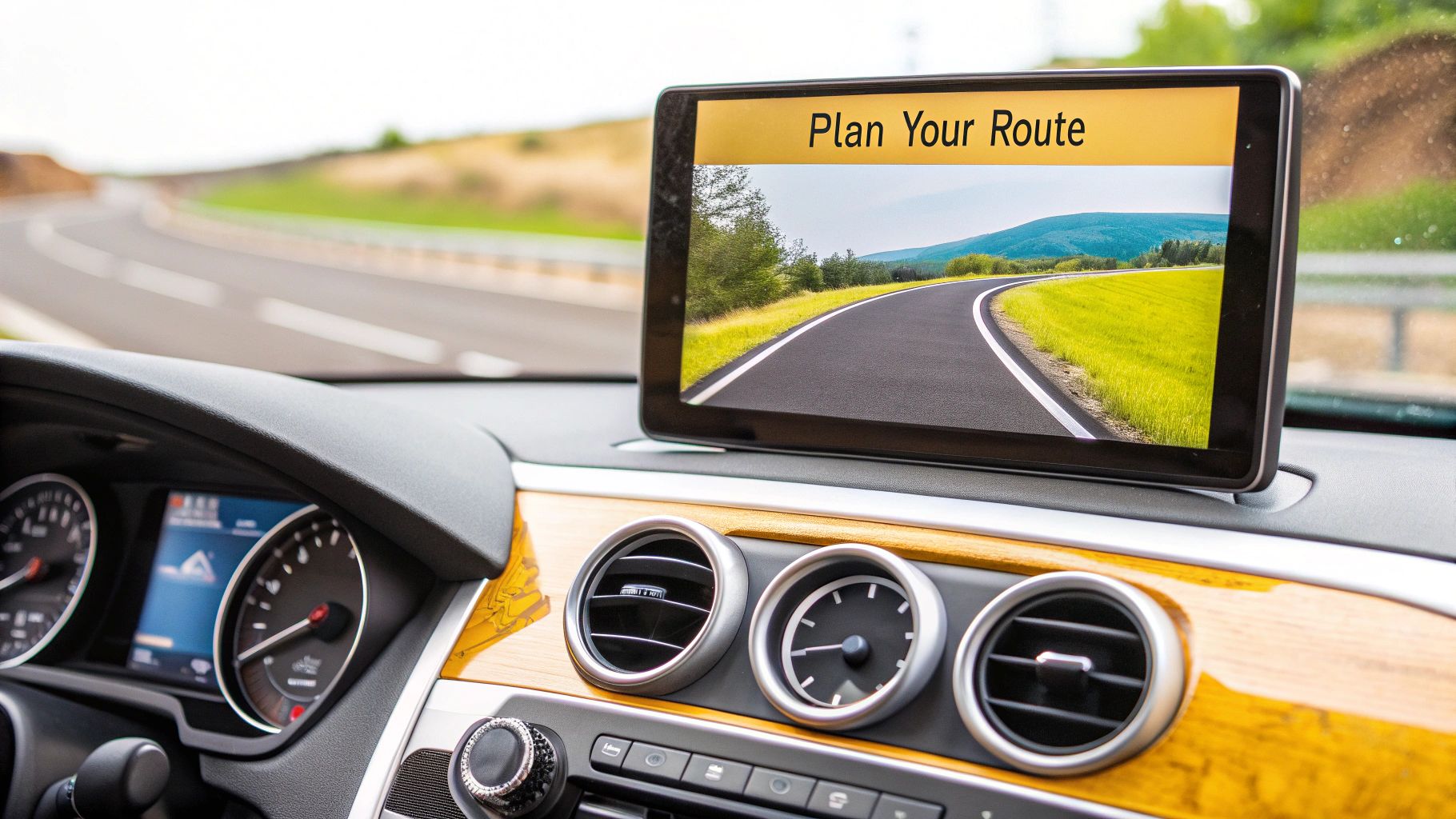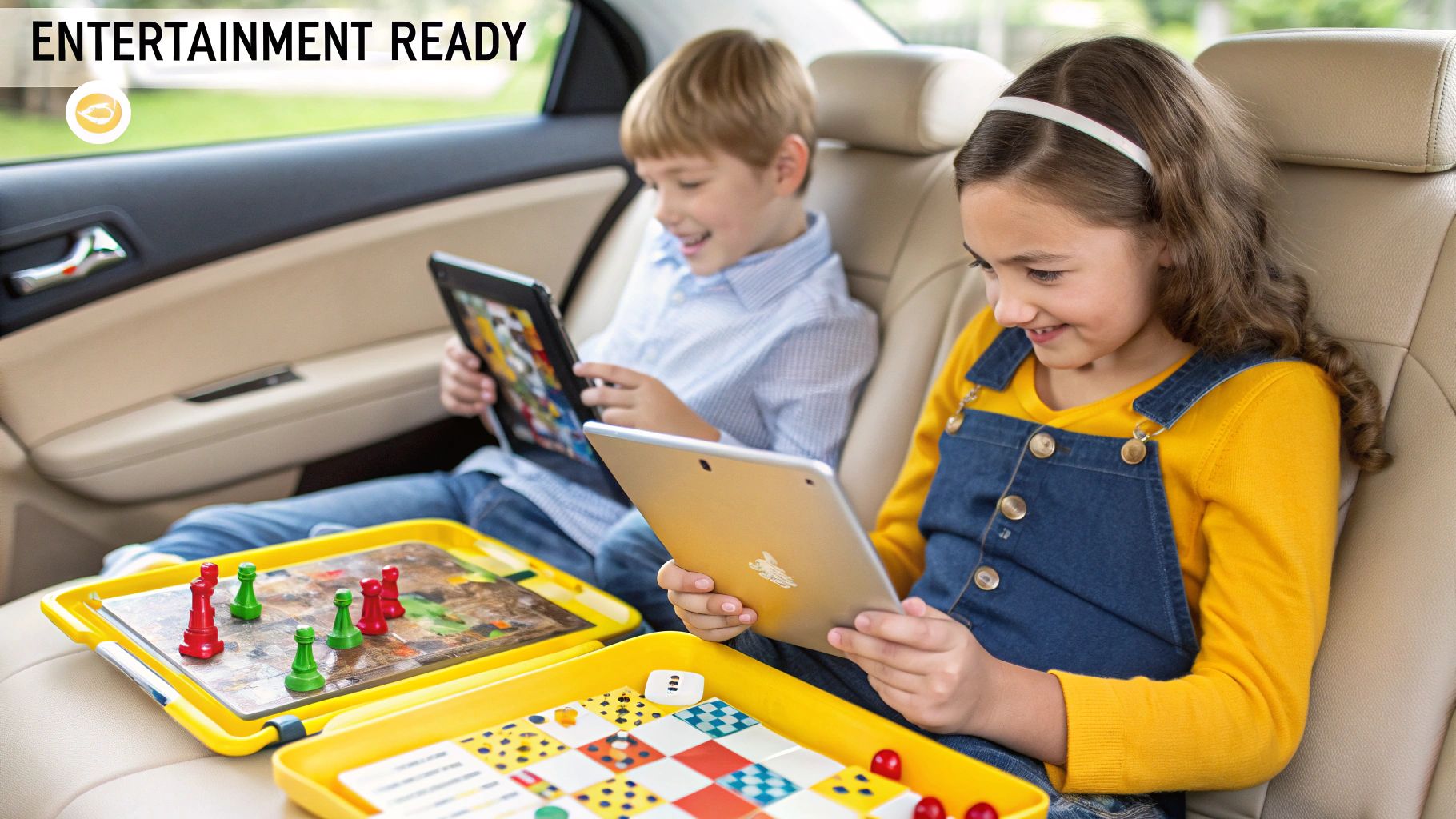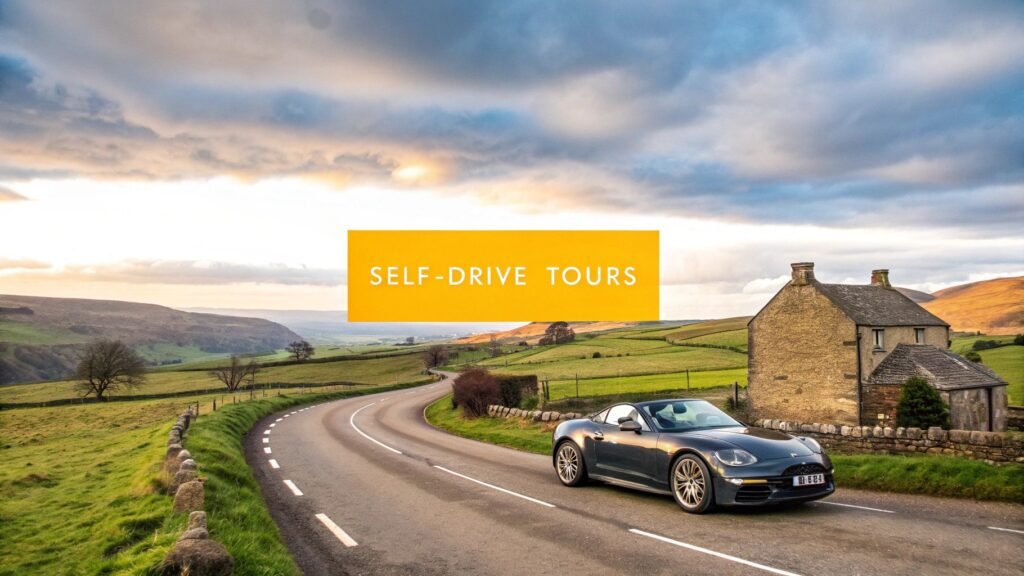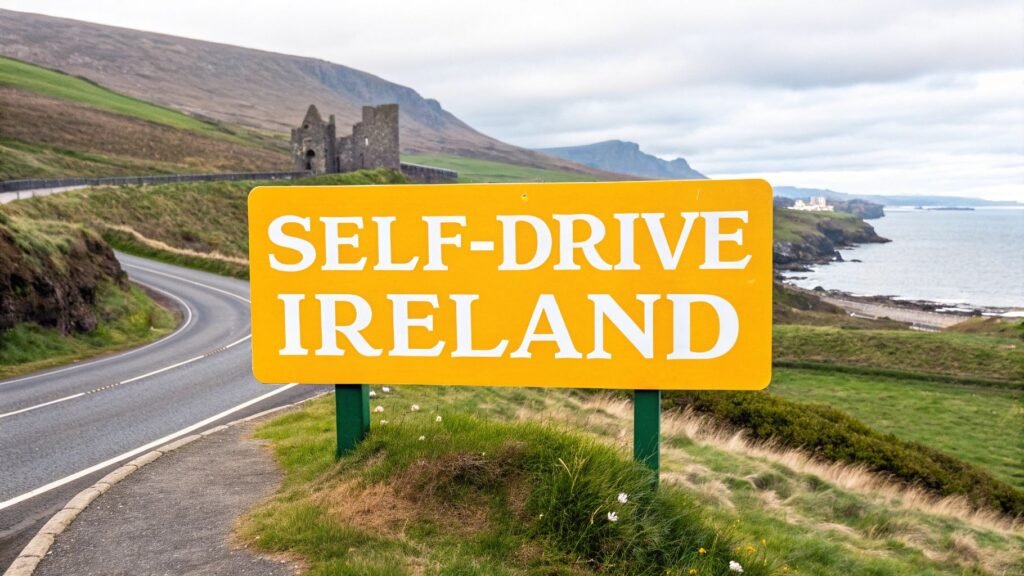Embarking on a multi-day self-drive tour is a fantastic way to explore the scenic landscapes of the UK and beyond. From the winding roads of the Scottish Highlands to the coastal charm of Cornwall, the freedom of the open road is exhilarating. However, long hours behind the wheel can quickly turn an adventure into an ordeal if you're not properly prepared. Standard advice often misses the mark, offering generic suggestions that fail to address the real challenges of extended travel. This guide goes deeper, providing a curated set of practical, experience-based tips for long car rides that will genuinely transform your journey.
We will move beyond the obvious to offer actionable strategies for everything from vehicle readiness and passenger comfort to emergency preparedness and in-car enjoyment. You will learn how to organise your vehicle for maximum efficiency, pack for any eventuality, and maintain morale over hundreds of miles. These insights are designed to ensure your next self-drive adventure is as smooth and memorable as the destinations themselves. Prepare to make every mile count by turning potential road trip fatigue into effortless exploration and discovery.
1. Master Your Route: Beyond Just Pointing the GPS
Strategic route planning is one of the most crucial yet overlooked tips for long car rides. It transforms a potentially stressful drive into a smooth, seamless part of your holiday. Rather than simply entering a destination into your satnav as you pull out of the driveway, true mastery involves anticipating the entire journey's rhythm well in advance. This means treating your route not just as a line on a map, but as a dynamic itinerary.

This proactive approach uses modern tools for intelligence gathering, not just turn-by-turn directions. By analysing your route days before you travel, you can identify potential traffic bottlenecks, check for scheduled roadworks, and pinpoint optimal departure times to avoid rush hour chaos. This preparation minimises delays, conserves fuel, and significantly reduces the stress of the unknown.
How to Implement Strategic Route Planning
Harnessing digital tools effectively is key. For example, using Google Maps' 'depart at' feature can help you visualise traffic density and avoid notorious congestion zones like the M25 during peak holiday travel. Similarly, apps like Waze use live, crowd-sourced data to adapt your route in real-time, often finding quicker alternatives to major A-roads.
By strategically layering your route with planned fuel stops, scenic viewpoints, and rest areas, you turn a simple drive into a seamless adventure.
This level of detail is especially vital for multi-day journeys. For those embarking on extensive road trips, such as the incredible journeys available on professionally curated self-drive tours, pre-planning becomes the foundation of the entire experience.
Actionable Route-Mastery Tips
- Pre-Departure Reconnaissance: A few days before your trip, check traffic patterns for your exact route. Look for recurring jams or delays that could impact your schedule.
- Go Offline: Always download offline maps for your entire route via Google Maps or HERE WeGo. This is a crucial backup for navigating through rural areas like the Scottish Highlands or Welsh valleys where mobile signal is unreliable.
- Plan Your Escape Routes: Identify at least two key alternative routes or major junctions where you can divert if you encounter an unexpected closure or standstill.
- Time Your Departure: Aim to leave during off-peak hours, typically between 10 AM and 2 PM. This simple strategy helps you miss both the morning and evening commute crush.
2. Pack a Comprehensive Emergency Kit
Having a well-stocked emergency kit is a non-negotiable tip for long car rides, moving beyond a simple first-aid box to full-spectrum readiness. It’s the ultimate insurance policy against the unexpected, providing crucial resources whether you're facing a minor breakdown on a quiet B-road or a more serious situation like being stranded in severe weather. Preparing for potential setbacks transforms anxiety into confidence, ensuring you have the tools to manage difficulties independently.

This preparation is about more than just convenience; it’s about safety. With millions of drivers requiring roadside assistance annually, and unpredictable events like winter storms stranding motorists for hours, a robust kit can be the difference between a manageable inconvenience and a genuine emergency. It equips you to handle everything from a flat tyre to personal first-aid needs, keeping you safe until help arrives.
How to Implement Emergency Preparedness
A truly effective kit is organised into two categories: vehicle essentials and personal survival items. The vehicle section should contain items like jump leads, a tyre inflator, and high-visibility warning triangles. The personal section should focus on your wellbeing, with items such as a first-aid kit, non-perishable food, water, and warm blankets. Beyond vehicle-specific items, for a broader perspective on general readiness and essential supplies, you might also consult an ultimate emergency preparedness checklist.
Your emergency kit isn’t just a collection of items; it's a system designed to provide safety, warmth, and sustenance when you are most vulnerable.
Organising these supplies in clearly labelled, durable containers in your boot ensures they are protected and easily accessible. This systematic approach is vital, preventing a frantic search during a stressful, low-light situation on the roadside.
Actionable Emergency-Kit Tips
- Vehicle-Specific Essentials: Include jump leads, a portable tyre inflator, a reflective warning triangle, a high-visibility vest, a torch with spare batteries, and basic tools like a multi-tool and adjustable wrench.
- Personal Survival Gear: Pack a comprehensive first-aid kit, foil blankets for warmth, bottled water, high-energy snacks like protein bars, and a portable power bank for your phone.
- Documentation and Contacts: Keep a written list of emergency contact numbers, your breakdown service details, and copies of important documents in a waterproof bag. Do not rely solely on your phone.
- Regular Maintenance: Check your kit every six months. Replace expired food, water, and medical supplies, and test batteries in your torch and power bank.
3. Schedule Regular Breaks Every 2 Hours
One of the most effective tips for long car rides is to combat driver fatigue before it even begins by adhering to the 'two-hour rule'. This simple yet powerful safety standard involves taking a dedicated 15-20 minute break for every two hours spent behind the wheel. It's a non-negotiable strategy for maintaining high levels of alertness and significantly reducing the risk of fatigue-related accidents, which remain a major cause of collisions on motorways and A-roads.
This methodical approach to rest prevents the gradual decline in concentration that often goes unnoticed during prolonged periods of driving. It’s a principle championed by road safety organisations worldwide, including the UK's Department for Transport, because it proactively manages the mental and physical strain of long-distance travel. The goal is to keep the driver as fresh in hour eight as they were in hour one.
How to Implement Regular Breaks
The effectiveness of this rule lies in its disciplined application. It isn't about stopping only when you feel tired; it's about stopping to prevent tiredness from setting in. This discipline is what separates a safe, enjoyable journey from a dangerously draining one. The value of this approach is validated by regulatory frameworks, such as the European Union's mandate requiring a 45-minute break for every 4.5 hours of commercial driving, proving its importance in professional contexts.
By treating breaks not as an interruption but as an integral, scheduled part of your journey, you transform them from a necessity into a refreshing and strategic advantage.
For travellers on extended self-drive tours, such as those through the winding roads of the Lake District or the vast landscapes of the Scottish Highlands, this systematic rest schedule is fundamental. It ensures you remain sharp and able to appreciate the stunning scenery safely.
Actionable Break-Time Tips
- Set Timed Reminders: Use your phone or vehicle's infotainment system to set a recurring alarm for every two hours. Treat this alarm as a non-negotiable signal to pull over at the next safe opportunity.
- Active Recovery: Use your 15-minute break to get out of the car and walk around. A short, brisk walk increases blood flow and combats the physical stiffness and mental lethargy that builds up while sitting.
- Switch Drivers: If travelling with another qualified driver, breaks are the perfect time to swap seats. This gives each person a chance for a proper rest period.
- Avoid Heavy Meals: During your breaks, opt for light snacks and water instead of a large, heavy meal. Big meals, particularly those high in carbohydrates and fats, can cause post-meal drowsiness, defeating the purpose of the stop.
4. Prepare Entertainment for All Passengers
Strategic entertainment planning is a cornerstone of successful tips for long car rides, transforming monotonous motorway miles into engaging, shared experiences. It's about more than just handing a child a tablet; it involves curating a diverse mix of media, games, and activities to suit all passengers and different stages of the journey. A well-prepared entertainment arsenal prevents boredom, reduces the likelihood of "are we there yet?" questions, and keeps the atmosphere in the car positive and light-hearted.

This proactive approach acknowledges that attention spans are finite, especially on multi-day tours. By organising a variety of options, you can cater to different moods and energy levels. The rise of streaming giants like Netflix and Spotify has revolutionised in-car entertainment, making it easier than ever to bring a vast library of films, music, and podcasts on the road, ensuring there is always something new to enjoy.
How to Implement Strategic Entertainment Planning
The key is a blend of digital and analogue options. Before departure, leverage features like Netflix's download function, which is used by millions of subscribers for travel. Similarly, creating a shared playlist on Spotify or downloading several audiobooks from Audible provides hours of screen-free listening pleasure that everyone can enjoy together. These digital preparations are crucial for navigating areas with poor mobile signal, such as the remote corners of the Lake District or rural Wales.
By curating a mix of shared audio experiences and individual activities, you create a flexible environment that caters to everyone's needs, making the journey itself a memorable part of the holiday.
This careful preparation is especially valuable for families or small groups undertaking extensive self-drive tours. Having a well-organised entertainment pack means less stress for the driver and a more harmonious trip for all passengers, allowing everyone to arrive at their destination feeling refreshed rather than frazzled.
Actionable Entertainment-Mastery Tips
- Download Everything in Advance: Never rely on mobile data. Before you leave, download films, playlists, podcasts, and audiobooks to all devices. This saves data and prevents disappointment in no-signal zones.
- Create an "Activity Bag": Pack a dedicated, easily accessible bag with non-digital entertainment. Include travel-sized board games, colouring books, sticker books, and classic car games like I-Spy or Bingo.
- Rotate Activities: Introduce a new activity or switch from a film to an audiobook every 1-2 hours. This rotation helps break up the journey into manageable segments and keeps passengers from getting restless.
- Pack a Surprise: Keep one or two new, exciting items hidden. Deploy these during particularly challenging stretches of the drive, like an unexpected traffic jam or the final hour of a long day, to provide a welcome boost of morale.
5. Pack Smart Snacks and Stay Hydrated
Proper nutrition and hydration are fundamental pillars of a successful road trip, directly influencing your energy levels, mood, and concentration. Strategically packing the right provisions is one of the most effective tips for long car rides, as it prevents the energy dips and irritability caused by hunger. It also reduces reliance on costly and often unhealthy motorway service station food, saving you both time and money.

This approach focuses on selecting non-perishable, mess-free options that provide sustained energy rather than a quick sugar rush followed by a crash. The success of brands like Yeti, which built its business on high-performance coolers for travel, and Costco's bulk snack packs, highlights a clear demand for better on-the-go food solutions. Planning your "car pantry" ensures you remain alert and comfortable throughout your drive.
How to Implement Smart Snacking
The key is preparation and choosing foods that are easy to eat while seated and won't create a mess. Think about snacks that offer a mix of protein, healthy fats, and complex carbohydrates for lasting energy. Pre-portioning items into individual, reusable containers before you leave makes them easy to distribute and minimises distractions while driving.
By curating your own snack selection, you take control of your in-car environment, ensuring comfort and sustained energy for the entire journey.
This level of food planning is especially valuable when your trip's focus is on unique local tastes, like those found on a culinary tour of Ireland, allowing you to save your appetite for the main event. Additionally, ensure your snacks contribute to your comfort by checking out these gut-friendly snack options.
Actionable Snack and Hydration Tips
- Pre-portion Everything: Before your trip, divide snacks like trail mix, chopped vegetables, and fruit into small, sealed bags or containers. This prevents overeating and makes them easy to hand out.
- Freeze Your Water: Freeze several water bottles the night before you leave. They will act as ice packs in your cool bag, keeping other items chilled, and will slowly thaw to provide cold water throughout the day.
- Prioritise Cleanliness: Pack a roll of paper towels and a packet of wet wipes in an easily accessible spot. These are invaluable for cleaning up inevitable spills and sticky fingers.
- Avoid Salty Foods: Steer clear of overly salty snacks like crisps and salted nuts. They increase thirst, leading to more frequent drink consumption and, consequently, more toilet stops.
6. Ensure Vehicle Maintenance and Inspection
A thorough pre-journey vehicle check is one of the most fundamental yet impactful tips for long car rides, acting as the ultimate insurance policy against preventable breakdowns. It's about moving from hopeful assumption to confident assurance that your vehicle is mechanically sound. Neglecting this step can turn a dream holiday into a roadside nightmare, while a well-maintained car provides peace of mind and significantly enhances safety.
This preventative approach involves a systematic inspection of all critical systems well before your departure date. Given that organisations like the AAA report that a majority of their 32 million annual roadside calls are for issues that could have been avoided with basic maintenance, this isn't just good practice; it’s a statistical necessity. Proactive checks minimise the risk of mechanical failures that lead to costly delays and dangerous situations on motorways.
How to Implement a Pre-Trip Vehicle Check
Implementing a proper inspection means going beyond just kicking the tyres. A crucial part of any long car ride is performing a thorough pre-flight check of your vehicle. For a detailed guide on ensuring your car is road-trip ready, consider consulting an essential maintenance checklist to cover all bases methodically. Scheduling a professional service one or two weeks before you travel gives you ample time to address any issues that arise without last-minute panic.
Investing an hour in vehicle checks before you leave can save you days of disruption and hundreds of pounds on your journey.
This systematic approach is your first line of defence against common road trip spoilers like overheating engines, battery failures, or tyre blowouts, which are responsible for thousands of accidents each year. It ensures every component, from the air conditioning to the spare tyre, is ready for the demands of a multi-day drive.
Actionable Maintenance Tips
- Schedule a Professional Service: Book your car in for a full service or at least an oil and filter change 1-2 weeks before your trip. Mention your upcoming road trip so the mechanic can pay special attention to key areas.
- Tyre Health Check: Check the pressure of all four tyres (and the spare) when they are cold for an accurate reading. Look for the correct pressure levels inside the driver's door jamb. Also, inspect the tread for wear and any signs of damage.
- Fluid Level Inspection: Check and top up all essential fluids: engine oil, coolant (antifreeze), brake fluid, and windscreen washer fluid. These are the lifeblood of your vehicle.
- Test All Electrics: Systematically check all your lights, indicators, and your horn. Also, test the air conditioning and heating system to ensure it functions correctly before you’re caught in a heatwave or a cold snap.
7. Optimise Seating and Comfort
Ensuring proper seating and comfort is a cornerstone of any successful long car ride, directly impacting driver alertness and passenger well-being. This goes far beyond simply finding a tolerable position; it involves consciously creating an ergonomic environment that prevents fatigue, body aches, and the dangerous drowsiness that can set in over hours of driving. Neglecting this crucial step can turn a dream road trip into an uncomfortable ordeal.
The principle is simple: your car should be an extension of a comfortable living space, not a confinement cell. Proactive comfort optimisation means using ergonomic accessories and making precise adjustments to your immediate environment. The surge in sales for items like lumbar support cushions during peak travel seasons highlights a growing public realisation of this need. Long-haul truckers and professional drivers have long understood this, often investing in custom modifications to protect their long-term health and maintain focus.
How to Implement Comfort Optimisation
Start by personalising your seating position before you even start the engine. Your seat should be adjusted so you can fully press the pedals without stretching, and your back should be firmly supported. Temperature is another key factor; a cabin that is too warm can induce sleepiness, while one that is too cold can cause muscle tension. Modern vehicles offer sophisticated climate control, which should be used to maintain a constant, comfortable ambient temperature.
A well-adjusted seat and a carefully managed cabin environment are your first line of defence against road fatigue and physical strain.
This focus on personal comfort is fundamental to enjoying the journey, a philosophy that underpins the diverse range of travel styles available for independent explorers. By customising your immediate space, you empower yourself to travel further and feel better.
Actionable Comfort-Optimisation Tips
- Pre-Drive Ergonomic Check: Before each driving shift, adjust your seat, headrest, steering wheel, and mirrors. Your headrest should support your head, not push it forward, and your wrists should rest comfortably on top of the steering wheel.
- Invest in Lumbar Support: Most car seats lack adequate lower back support. A simple memory foam or mesh lumbar pillow can make a world of difference, preventing back pain on long stretches.
- Strategic Item Placement: Keep essential items like water, snacks, sunglasses, and charging cables within easy reach to avoid stretching or awkward movements while driving.
- Maintain an Alerting Temperature: Set your climate control to a cool but comfortable temperature, around 19-21°C. If you feel drowsy, briefly lower the temperature or open a window for fresh air.
7 Essential Tips Comparison for Long Car Rides
| Item | Implementation Complexity 🔄 | Resource Requirements ⚡ | Expected Outcomes 📊 | Ideal Use Cases 💡 | Key Advantages ⭐ |
|---|---|---|---|---|---|
| Plan Your Route and Check Traffic | Medium 🔄 | Smartphone/GPS device | Reduced travel time by 15-30% 📊 | Avoiding traffic delays, long-distance trips | Minimizes stress, better scheduling |
| Pack a Comprehensive Emergency Kit | Medium-High 🔄 | Emergency supplies, storage space | Increased safety and peace of mind 📊 | Long drives, remote areas | Potentially life-saving, cost-saving |
| Schedule Regular Breaks Every 2 Hours | Low 🔄 | Planning rest stops, time allocation | Reduces accident risk by up to 40% 📊 | All long-distance drives | Prevents fatigue, improves alertness |
| Prepare Entertainment for All Passengers | Medium 🔄 | Digital/analog content, devices | Reduced passenger complaints by 60-70% 📊 | Family trips, group travel | Keeps passengers engaged and calm |
| Pack Smart Snacks and Stay Hydrated | Low-Medium 🔄 | Cooler space, snacks, water | Saves 30-50% on food costs 📊 | Sustained energy on long drives | Prevents motion sickness, steady energy |
| Ensure Vehicle Maintenance and Inspection | Medium-High 🔄 | Time, basic mechanical skills or service | Prevents 80% of common breakdowns 📊 | Pre-trip preparation | Improves safety and fuel efficiency |
| Optimize Seating and Comfort | Low-Medium 🔄 | Ergonomic accessories, seat adjustments | Reduces back pain by 50% 📊 | Long drives, multiple drivers | Enhances comfort and alertness |
Your Adventure Awaits, Perfectly Prepared
The open road is a canvas for adventure, a promise of new landscapes, hidden heritage sites, and unforgettable cultural experiences. Yet, the quality of that adventure is often determined long before the engine starts. A truly great self-drive tour is not defined by the absence of challenges, but by how well you prepare for them. The difference between a stressful, draining drive and a memorable, invigorating journey lies in the small details, the thoughtful preparations that transform a long-distance drive from a necessary evil into an integral part of the experience.
By integrating the seven essential tips for long car rides we've explored into your planning, you’re not just packing a car; you’re engineering a better holiday. You are taking proactive control over your comfort, safety, and enjoyment. Mastering these strategies empowers you to turn potential frustrations into minor, manageable events. A traffic jam becomes an opportunity to enjoy a podcast, not a source of anxiety. A rumbling stomach is met with healthy, pre-packed snacks, not a desperate search for a service station.
Turning Knowledge into Action
The most crucial takeaway is that preparation is not about eliminating spontaneity. Instead, it’s about creating a secure foundation from which you can be spontaneous. Think of it as a framework for freedom.
Here’s how to put these insights into practice for your next trip:
- Create a Master Checklist: Before your next tour, build a reusable checklist based on the seven pillars we've discussed. Include sections for vehicle maintenance, your emergency kit, snack and hydration planning, and entertainment downloads.
- Conduct a 'Dry Run': For a shorter trip, practise implementing these strategies. Test out your seat cushion, see how your snack cooler performs, and get your family used to the idea of regular, structured breaks.
- Delegate Responsibilities: Make preparation a group activity. Assign one person to be the 'DJ' in charge of playlists and audiobooks, another to be the 'Snack Master', and another to double-check the route and planned stops.
This holistic approach ensures that when you arrive at each destination on your itinerary, whether it's a magnificent historic castle in England or a remote, scenic viewpoint in the Scottish Highlands, you step out of the car feeling refreshed, energised, and ready to explore. You’ve invested in your well-being, ensuring the journey enhances, rather than detracts from, your destination. The open road is calling; now you have the expert knowledge to answer it with confidence, turning your next self-drive tour into a collection of lifelong memories.
Ready to put these tips into action on a perfectly planned route? The self-drive tours from BTOURS are designed with driver comfort and enriching experiences in mind, taking the stress out of planning so you can focus on the journey. Explore our curated itineraries at BTOURS and discover your next great British adventure.



